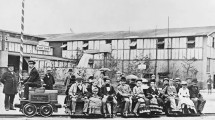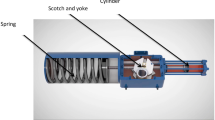Abstract
A passive magnetic levitation (maglev) carrier is a transportation device that is based on magnetic levitation and does not have any electric circuits on the moving part. Because the actuation devices are not in the moving platform for passive operation, the levitation forces are non-homogenous. This characteristic makes the design and control of the system challenging. We present design and control procedures for a passive maglev carrier system. To achieve stable and accurate levitation, mechanical analyses were performed to determine the configuration and locations of the levitation magnets. The key challenge in the control design is that the locations and magnitudes of the levitation forces are not continuous around the edge of the moving platform when it passes the magnet. Therefore, the longitudinal positions of the magnets relative to the moving platform are a noise (uncontrollable) factor for the controller. The control parameters should be robust against the noise factor to achieve reliable performance. The Taguchi method was used to determine the optimal control parameters in the presence of the noise factor. The optimized gain reduced the position variation of the levitated carrier by 50% in terms of the root mean square error.
Similar content being viewed by others
References
Park, J. S., Kim, J. S., and Lee, J. K., “Robust Control of Maglev Vehicles with Multimagnets using Separate Control Techniques,” KSME International Journal, Vol. 15, No. 9, pp. 1240–1247, 2001.
Seo, S. I., Lee, M. K., Kim, S. J., and Kim, N., “Robust Optimum Design of a Bearingless Rotation Motor using the Kriging Model,” Int. J. Precis. Eng. Manuf., Vol. 12, No. 6, pp. 1043–1050, 2011.
Park, K., Choi, K. B., Kim, S. H., and Kwak, Y. K., “Design of Magnetically Suspended Frictionless Manipulator,” KSME Journal, Vol. 9, No. 3, pp. 323–335, 1995.
Han, H. S., Kim, C. H., Lee, J. M., and Lee, C. W., “System Integration of a Non-Contact Conveyer using Magnetic Levitation Technology,” Proc. of IEEE International Conference on Mechatronics (ICM), 2011, pp. 708–712, 2011.
Bleuler, H., “A Survey of Magnetic Levitation and Magnetic Bearing Types,” JSME International Journal. Ser. 3, Vibration, Control Engineering, Engineering for Industry, Vol. 35, No. 3, pp. 335–342, 1992.
Kim, W. J. and Trumper, D. L., “High-Precision Magnetic Levitation Stage for Photolithography,” Precision Engineering, Vol. 22, No. 2, pp. 66–77, 1998.
Kim, W. J. and Verma, S., “Fabrication and Control of a 6-DOF Magnetic Levitation Stage with Nanopositioning Capability,” Proc. of American Control Conference, Vol. 3, pp. 2487–2492, 2004.
Balas, G. J., Doyle, J. C., Glover, K., Packard, A., and Smith, R., “μ-Analysis and Synthesis Toolbox,” Mathworks, pp. 76–87, 1993.
Skogestad, S. and Postlethwaite, I., “Multivariable Feedback Control: Analysis and Design,” Wiley New York, 1st Ed., pp. 355–403, 1996.
Fowlkes, W. Y. and Creveling, C. M., “Engineering Methods for Robust Product Design,” Addison-Wesley, pp, 1–2, 1995.
Peace, G. S., “Taguchi Methods: A Hands-on Approach,” Addison Wesley Publishing Company, pp. 13–22, 1993.
Taguchi, G., “Taguchi on Robust Technology Development Bring Quality Engineering Upstream,” ASME Press, pp. 17–27, 1993.
Ferrell, W. G. and Reddivari, V. R., “Higher Quality Products with Better Tuned Controllers,” Computers & Industrial Engineering, Vol. 29, No. 1, pp. 321–325, 1995.
Misal, S. A., Gaikwad, R. W., and Sathe, V. S., “Optimization of Control Parameters using Improved Relay Tuning and Taguchi Method,” International Journal of ChemTech Research, Vol. 3, No. 3, pp. 1081–1087, 2011.
Asokan, T. and Asokan, T., “A Self-Tuning Proportional-Integral-Derivative Controller for an Autonomous Underwater Vehicle, based on Taguchi Method,” Journal of Computer Science, Vol. 6, No. 8, pp. 862–871, 2010.
Lee, K. and Kim, J., “Controller Gain Tuning of a Simultaneous Multi-Axis PID Control System using the Taguchi Method,” Control Engineering Practice, Vol. 8, No. 8, pp. 949–958, 2000.
Ryckebusch, E. F. and Craig, I. K., “PID Tuning for a Multivariable Plant using Taguchi-based Methods,” Proc. of 15th Triennial IFAC World Congress, pp. 21–26, 2002.
Zhou, D. and Li, J., “Analysis of the Low-Frequency Vibration of Ems Maglev Vehicles,” Proc. of IEEE International Conference on Control and Automation, pp. 3157–3161, 2007.
Fien, S. E. and Hinkley, D. V., “A Review of R.A. Fisher: An Appreciation,” Springer, pp. 482–490, 1980.
Park, J. W., Kim, C. H., Park, D. Y., and Ahn, C., “Controller Design with High Fidelity Model for a Passive Maglev Tray System,” Int. J. Precis. Eng. Manuf., Vol. 15, No. 8, pp. 1521–1528, 2014.
Author information
Authors and Affiliations
Corresponding author
Rights and permissions
About this article
Cite this article
Li, S.E., Park, JW., Lim, JW. et al. Design and control of a passive magnetic levitation carrier system. Int. J. Precis. Eng. Manuf. 16, 693–700 (2015). https://doi.org/10.1007/s12541-015-0092-3
Received:
Revised:
Accepted:
Published:
Issue Date:
DOI: https://doi.org/10.1007/s12541-015-0092-3




